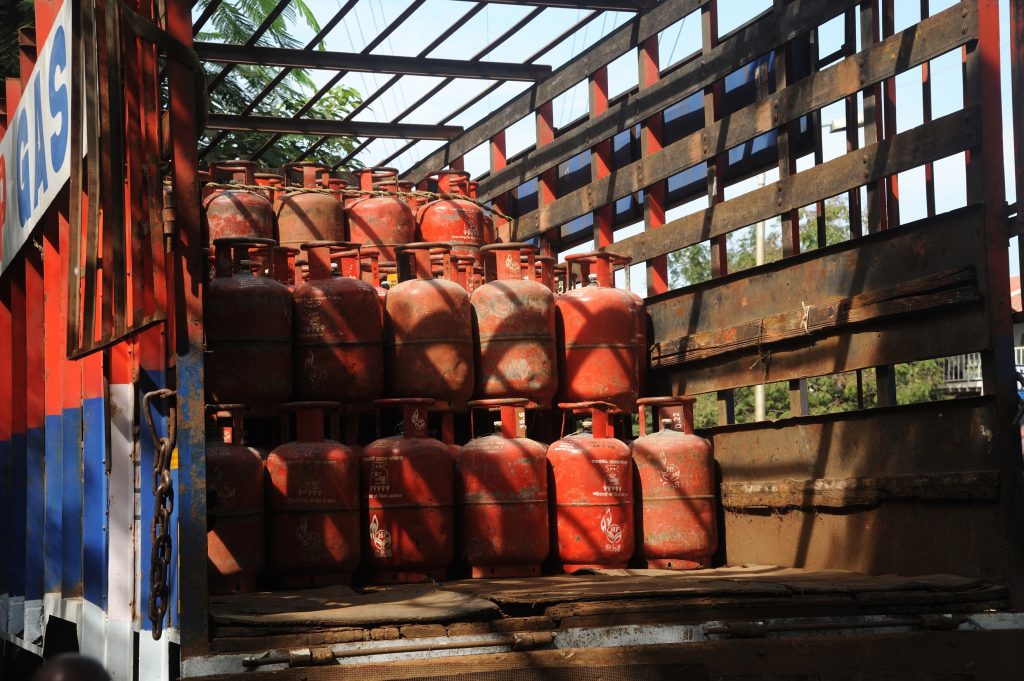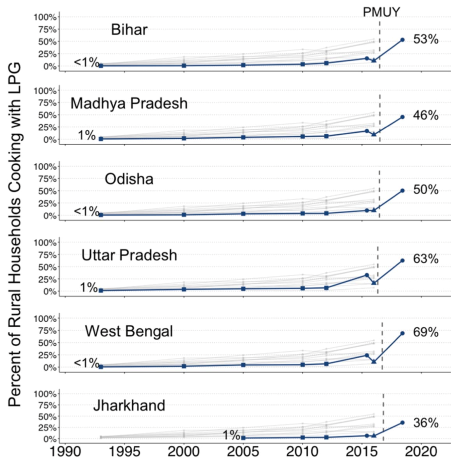Blog

Since 2016, about 80 million new LPG connections have been established in India under the flagship clean cooking policy Pradhan Mantri Ujjwala Yojana (PMUY). However, even with increased LPG adoption, majority of the rural households in India continue to use solid fuels. This was observed in our recent Initiative for Sustainable Energy Policy (ISEP) study that sought to model the drivers of adoption as well as use of clean cooking fuels in rural India.
The findings of this study are based on a panel dataset of over 8,500 rural households that were first interviewed in 2014-15, and then again in 2018. This rural energy access survey (ACCESS) covered six energy-poor states in India – Bihar, Madhya Pradesh, Odisha, Uttar Pradesh, West Bengal, and Jharkhand.
Our results suggest that the factors that determine LPG adoption – household expenditure and education – also explain LPG consumption. However, in terms of amount of LPG consumed, PMUY beneficiaries were found to be consuming about 30% less LPG as compared to the non-beneficiaries (general consumers) even after accounting for socio-economic and demographic differences.
Here are the main findings of the study in more detail:
- LPG access increased but majority households still solid fuels
We found that both LPG adoption and use increased among the surveyed households between 2015 and 2018. In 2015, 75% of the surveyed households did not use LPG; in 2018, this proportion had reduced to 45%. Exclusive use of LPG also grew between the two survey years, increasing from 5% in 2015 to 17% in 2018.

Figure 1: Increase in LPG use in rural households in the six study states. The blue lines refer to the proportion of households using LPG as a cooking fuel in the study states, while the grey lines refer to rest of the states over the same time period.
However, the use of solid fuels, especially firewood, remained prevalent as 83% of the study households reported using solid fuels to meet at least some of their cooking needs in 2018. Increased adoption of LPG along with prevalence of solid fuels has increased ‘fuel stacking’ of LPG and solid fuels in rural India. Both these observations highlight that cessation of solid fuel use for cooking remains an important policy challenge in rural India.
- PMUY beneficiaries consume relatively less LPG
We also found the beneficiaries of PMUY in our sample to be consuming nearly two large cylinders of LPG less as compared to the general consumers each year. After adoption, the general LPG consumers were predicted to consume 93 kilograms of LPG per year on average. However, PMUY beneficiaries were predicted to consume 27 kilograms less on average (almost equivalent to two 14.2 kg cylinders).
We accounted for possible factors of socio-economic differences between PMUY beneficiaries and general consumers such as education, monthly expenditures, caste, household size, gender of the decision-maker, age of the household head, and years with LPG and even then found the scheme beneficiaries to be consuming lesser amount of LPG. Our findings correspond to the growing evidence that PMUY beneficiaries consume less LPG in comparison to the general customers.
- Cost and cylinder delivery remain barriers
Finally, we conducted an exploratory analysis of perceptions, and preferences associated with LPG use to better understand the barriers to exclusive use of LPG, and the differing consumption patterns of PMUY beneficiaries and general consumers.
Cost of the LPG cylinder refill was the most commonly reported barrier to LPG use among both groups. However, we observed a gap in the access to LPG cylinder refills between PMUY beneficiaries and general customers. Fewer PMUY beneficiaries reported having cylinders delivered to their doorsteps as compared to general customers. Moreover, PMUY beneficiaries travelled longer distances to get refills when compared to other households without doorstep delivery. This reason for this gap could be that PMUY beneficiaries live in remote villages where LPG ownership has previously been low. In order to improve the access to LPG, it is important to widen the network of local distributors of LPG.
Moving forward, the important policy challenge is to ensure exclusive use of LPG in rural Indian households. Measures that can increase the affordability, and accessibility of clean cooking fuels such as lower fuel costs, expansion of distribution networks, and awareness programs aimed at increasing awareness about the health benefits of using clean fuels, and safe handling of LPG cylinders are required.
Burning solid fuels for cooking results in household air pollution (HAP) which is a major health risk that disproportionately affects women and children. Partial transition to LPG is unlikely to significantly reduce the health risks associated with solid fuels. Hence, India needs to build upon the advances made in LPG adoption, and work towards exclusive and sustained use of LPG.
***
Anjali Sharma is Wellcome Postdoctoral Fellow (2020-2022), currently affiliated with the Energy, Resources, and Environment (ERE) program at SAIS, Johns Hopkins University.
